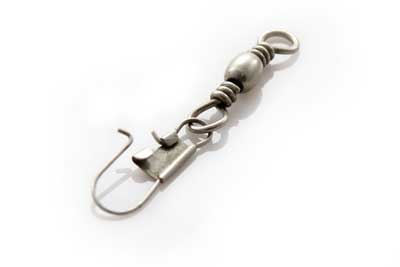Fishing Snaps

 Save time using snaps
Save time using snaps
They facilitate quick changing of lures and baits. Even with their limitations, we highly recommend the use of snaps especially if you’re constantly changing lures and baits. The more time you spend with your line in the water, the more fish you’ll catch.
How to pick the right snap for the job
Materials
Most are steel wire that are plated carbon steel or stainless steel. These finishes are all about strength and helping to prevent corrosion. Corrosion leads to weakening of the snap.
Due to the nature of the design, snaps will eventually break and wear. Monitor wear and replace when the snapping appears weak to prevent the loss of a more expensive lure.
Types, best use, pros & cons, best & worst. You’ll find this information here.
|
|
Duo-lock Snap
 The Duo-lock snap is made from a single piece of spring tempered wire.
The Duo-lock snap is made from a single piece of spring tempered wire.
It offers a round bend that is wide, secure, light weight and strong. These snaps come in test sizes from 20 to 150 pounds.
We highly recommend the Duo-lock snap.
Coastlock Snap
Like the Duolock, the Coastlock snap is strong, secure and dependable and is also one of the most popular snaps available.
It has an asymmetrical design, which causes some movement restriction to the lure, but it offers a major advantage over other snaps.
Pros:
- When it’s overstressed, the wire begins to bend, but the loop that closes the snap slides along the shank preventing it from opening. Albeit a little deformed.
Cross-Lok Snap
Cross-lok was introduced by Berkley in 1979 with a double-ended snap like the coastlock.
Pros:
- This provides great flexibility for rigging and provides for great strength and is considered quite secure
- It offers high-test strength ranging from 40 pounds up to 200 pounds
- It’s slim and highly resistant to snagging
Ampersand Snap
The ampersand clip is aptly named from the appearance of the clip.
Pros:
- It’s more secure than the fly clip and the Ampersand snap is used by spin anglers and the choice fly fishing snap.
Butterfly Snap
Pros:
- The butterfly snap is a popular snap used for offshore trolling and is essentially a single piece of wire bent in that it resembles a coastlock snap.
McMahon Snap
Pros:
- This snap is used mainly for offshore trolling for tuna or black marlin.
Lock Snap, Interlock and Locking Snap
The lock snap is wide and offers a round bend design, which is perfect for attaching lures. This is a very popular design, and as a result there are varying degrees of quality.
Most of the problems associated tempering, drawing and wire grade can be avoided if low cost snaps are ignored. As with all snaps, perform multiple openings and closing to test its quality. Throw out the snap if it fails to lock properly after a few tries.
Fly Clips
 This has to be the smallest and lightest of all the connectors and snaps. Some call these the lazy man’s clip and are used for fly fishing.
This has to be the smallest and lightest of all the connectors and snaps. Some call these the lazy man’s clip and are used for fly fishing.
Cons:
- These clips are not considered secure.They offer moderate security if the attaching fly wire is not larger than the fly clip.
Safety Snap
The safety snap is the oldest of the snaps.
Cons:
- It’s asymmetrical and not a good choice for attaching lures. It offers little in terms of security and strength over other popular snaps
- Regardless of the construction, these snaps can be pulled apart in heavy action
Pompanette Snap
The Pompanette snap has the same advantages as the Coastlock snap but differs in that it has a sharper bend and narrower width, which makes it less acceptable for lures.
Snap Wires
Avoid snap wires made of brass as they’re too heavy and easily deformed. Steel snap wires must be hard and spring tempered otherwise the snap will come open and all is lost.
To test the snap, open and close it a few times. If it doesn’t lock properly each time, it’s too soft and should be discarded.
Size
The larger the snap, the more resistance or drag in creates in the water. There are two types, the sampo and the bead chain.
- The sampo uses thinner wire, shaped longer and wider than the bead wire snap.
- The bead snap uses thicker wire and is heavier and bulkier.
Tip: As both are quite dependable, go with the lighter Sampo snap where weight and drag are important.
Shape
While all snaps have a different shape, the strongest snaps all have asymmetrical bends. However, a symmetrical bend is wider and provides more movement or range for the lure or bait.
Be aware that larger snaps will inhibit the lure’s action as a result of it’s weight.
Once again, it is all about the balance of all components from rod to lure.
Lockfast Snap
Lockfast snaps are made from brass wire, which is it’s major flaw as brass is soft and unreliable as a material for making snaps.
Note: Stay away from these snaps and stick to the Duolock.
Corkscrew Snap
The corkscrew is a connector and not a snap despite it’s namesake. It rates highly alongside the coastlock, pompanette and cross-lok for it’s strength and security.
Pros:
It’s also one of those snaps that can easily be made by amateur anglers.


